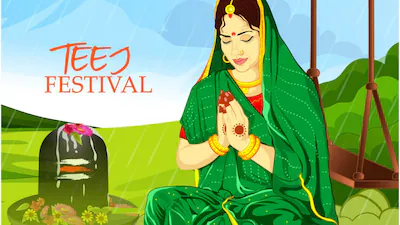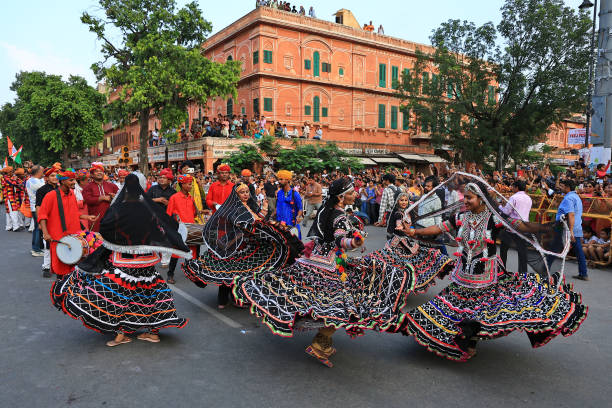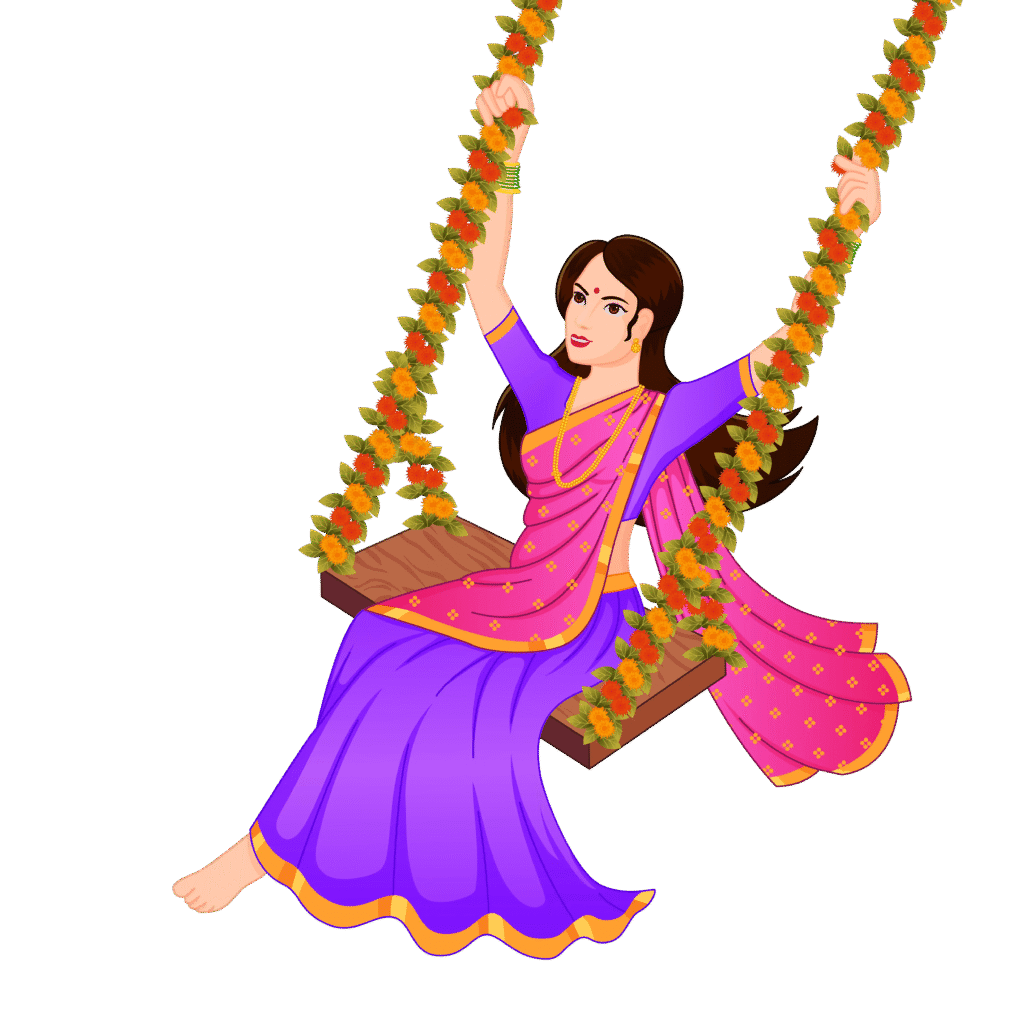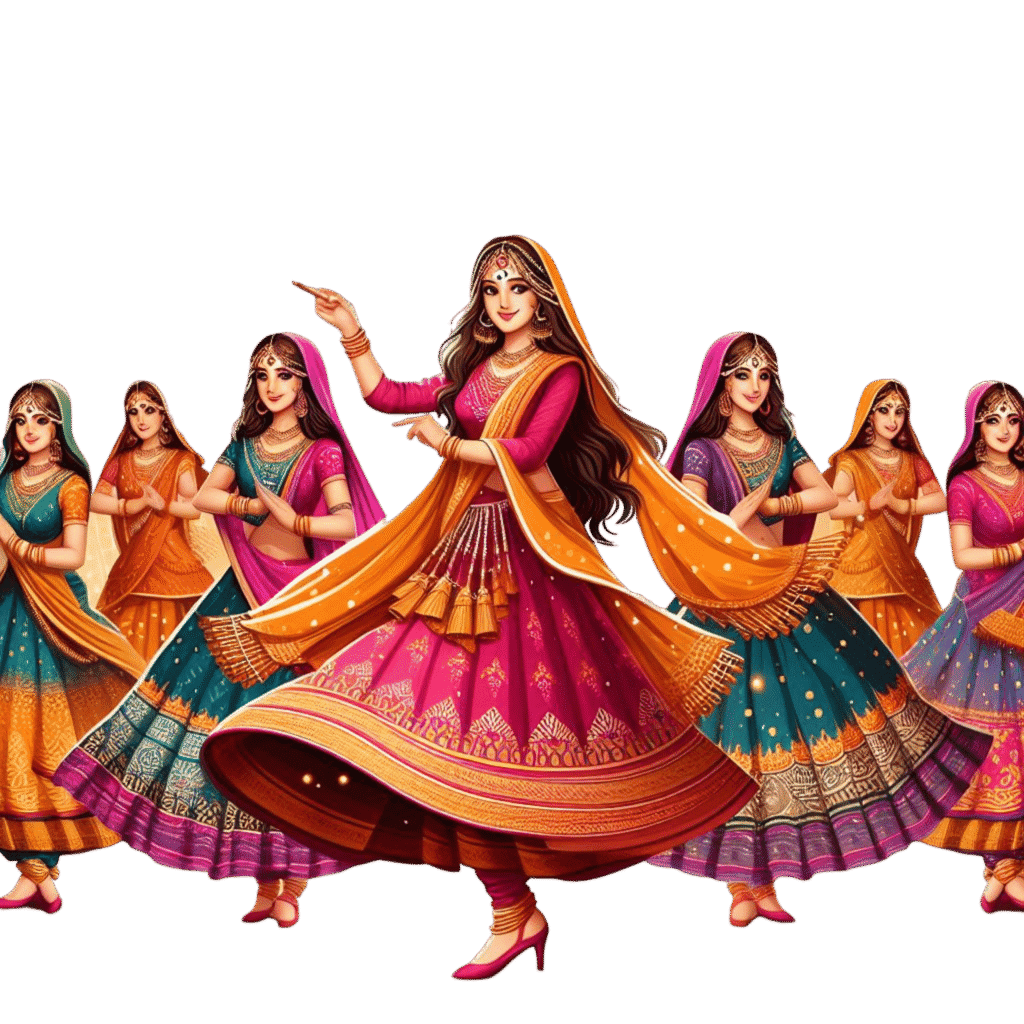
Table of Contents
Introduction
Teej Festival is one of the most colorful and rich cultural festivals of India, welcoming the arrival of the monsoon and celebrating conjugal happiness and fidelity.
This cultural festival is mostly observed by the women, who observe fasting, puja, and merrymaking. The best among the many types of Teej is Haryali Teej, which is a festival of greenery, abundance, and fertility of Nature.
Since ancient times, the Teej Festival has been connected with devotion to Lord Shiva and Goddess Parvati. The wife prays for the health of her husband, desires conjugal bliss, and rejoices in the fertility of the soil with rituals, ballads, and dances.
The festival is an integral cultural experience, with devotion, tradition, and social celebrations.
From Uttar Pradesh to Rajasthan, Madhya Pradesh to Bihar, Haryali Teej is a festival that brings people together with its bright hues, music, and dance.
From vibrant swings suspended over trees to temples exquisitely decorated, the festival is a sensory experience and a celebration of India’s vibrant heritage.
This blog delves into the 7 most vibrant celebrations of the Teej Festival, showcasing the rituals, cultural importance, and festive mood of Haryali Teej, and making this cultural festival of India a must-watch.
Festivals of Rajasthan: 10 Incredible Traditional Celebrations
Origin and Background of Teej Festival
The Festival of Teej originates from Hindu mythology. The festival is closely aligned with the mythology of Goddess Parvati, who undertook rigorous penance to satisfy Lord Shiva and win his love and ultimately to be his loving wife.
The festival is a celebration of Parvati’s devotion and of conjugal happiness, and that’s the source of Haryali Teej.
Historically, Teej was celebrated in royal courts and villages alike, with women performing rituals, singing folk songs, and engaging in community activities.

Over the centuries, it evolved into a cultural festival that not only honors marital bonds but also celebrates the rejuvenation brought by the monsoon.
The festival took special significance in Rajasthan, with people festooning swings (pavitra jhoolas), fairs, and traditional dancing.
Temples get beautifully decorated and local markets come alive. The coming together of religious spirit and cultural celebrations ensures that the Teej Festival stands apart as a celebration of Indian traditions.
Significance of Haryali Teej
Haryali Teej is one of the most cherished festivals in North and Western India, carrying religious, cultural, seasonal, and social importance.
Celebrated during the month of Shravan (Sawan), when the earth is covered in greenery, it symbolizes prosperity, fertility, love, and the blessings of nature.
Its rituals and traditions go far beyond mere customs — they are deeply rooted in spiritual devotion, feminine strength, and the celebration of life.
1. Religious Significance
- Union of Shiva and Parvati: According to Hindu mythology, Goddess Parvati observed intense penance and over 108 births of austerity to win Lord Shiva as her consort.
- Haryali Teej commemorates the day when her devotion was finally rewarded, and she was accepted by Lord Shiva as his eternal companion.
- Symbol of Marital Bliss: For married women, the festival holds special meaning. They observe fasts and rituals, seeking blessings for the long life and prosperity of their husbands. For unmarried women, it is believed to bring a suitable life partner blessed by Goddess Parvati.
- The festival is therefore seen as a symbol of unbreakable love, loyalty, and the sanctity of marriage.
2. Cultural Significance
- Celebration of Womanhood: Haryali Teej is not only about devotion but also about the joy and vibrancy of women coming together. Women wear green sarees and bangles, apply mehendi (henna), and sing folk songs that celebrate love and monsoon.
- Folk Traditions: Communities gather for cultural performances, group dances, and rituals, turning villages and towns into hubs of festivity. The green color, associated with Haryali (nature’s abundance), symbolizes growth, fertility, and happiness.
- Gifts and Traditions: Parents often send “Sindhara” (gifts of clothes, sweets, and jewelry) to married daughters, strengthening family ties and honoring the bond between parents and daughters.
3. Seasonal & Natural Significance
- The word Haryali literally means greenery, reflecting the earth’s transformation during the monsoon season. Fields bloom with crops, rivers overflow, and the land becomes fertile.
- Swings hung from trees, decorated with flowers, become an integral part of the festival. Women sing songs while swinging, symbolizing joy, renewal, and harmony with nature.
- By celebrating the rains, Haryali Teej becomes a festival of gratitude to nature, acknowledging the life-giving role of water and greenery.
4. Spiritual & Devotional Significance
- The festival emphasizes self-discipline and devotion through fasting (often nirjala vrat, where women abstain from even water).
- The fast is not merely a ritual but a spiritual offering of love, purity, and faith towards Goddess Parvati and Lord Shiva.
- Women believe that by observing these penances with devotion, they can ensure marital harmony, peace, and prosperity in their households.
5. Social & Community Significance
- Haryali Teej strengthens sisterhood and female bonding. Women visit each other’s homes, apply mehendi together, exchange sweets, and celebrate as a community.
- Fairs and processions are organized in cities like Jaipur, where idols of Parvati are taken out with pomp, accompanied by music, dance, and colorful displays of culture.
- The festival also allows women to take a break from daily responsibilities and immerse themselves in joy, music, and togetherness.
6. Symbol of Feminine Energy and Empowerment
The festival acts as a reminder of the spiritual and cultural importance of women in sustaining families, traditions, and society.
Haryali Teej honors the divine feminine energy (Shakti) through the devotion of Goddess Parvati.
It reflects women’s strength, patience, and resilience, qualities that are celebrated through rituals and festivities.
7 Vibrant Celebrations of Teej Festival
Swing Parties (Pavitra Jhoola) On H
The legendary swing parties, or Pavitra Jhoola, are synonymous with Haryali Teej. Flowers, colorful clothes, and beads decorate the trees to provide a visual treat to the festival visitors.

The womenfolk swing on elegantly decorated swings one by one and sing rural songs narrating the tales of Goddess Parvati and her devotion to Lord Shiva.
The swing is not only an enjoyable ride but also a ritualistic act—an expression of freedom, happiness, and the circular flow of life.
Groups of people will typically come together in courtyards or temple courtyards to enjoy this ritual, and thus it becomes a social and spiritual activity.
More than its beauty, the swing festival reinforces bonds between females, extending friendships and mutual happiness. The amusement of the fun swings attracts the youngsters, too, and the festival becomes a whole-family affair.
Rajasthani Traditional Attire and Jewelry
During the Teej Festival, traditional clothes are worn by women, adding to the festival’s vibrant and cultural mood.
In the north Indian states and Rajasthan, ghagras (long skirts), cholis (tops), and odhnis (scarves) are worn and typically decorated with fine embroidery, mirror works, and bright colors.
The occasion holds paramount importance with respect to jewelry. The ladies deck up with necklaces, bangles, nose rings, and earrings that signify local craftsmanship.
Mehndi (henna) is marked on hands and legs with elaborate designs to represent beauty, fortune, and conjugal bliss.
This aspect of the Teej Festival centers on the artistic beauty of the festival and links it intensely with local culture, and this becomes a cultural festival truly reflecting the artistic heritage of India.
Folk Dance Performances and Folk Songs
No festival of Teej is ever without the traditional folk music and dances. The ladies sing together the Teej melodies that tell of Parvati’s devotion, conjugal love, and the happiness of the rains.

The favorite dances that are sung and performed by ladies in circular or synchronized patterns are the Ghoomar and Kalbelia.
These performances and dances are spiritual and social. They offer a vibrant background and involve the entire community.
They are accompanied by singing supported by cymbals and ancient drumbeats, and the entire event becomes rhythmic, interactive, and celebratory.
Haryali Teej’s ballads and dances are passed down through generations of individuals to keep the cultural heritage fresh and vibrant each and every year.
Temples and Religion Rituals
An important aspect of the Teej Festival is visiting Lord Shiva and Goddess Parvati temples. The ladies make special pujas (prayers) and offer flowers, fruits, and sweets to ask for blessings of conjugal bliss, wealth, and health of their families.
Certain rituals involve fasting, swinging off beautifully decorated swings close to temples, and storytelling of Parvati’s devotion. They add a spiritual dimension to the festival by relating the cultural pomp of the community to devotion and religiosity.
The temples will be embellished with rangoli designs, light, and marigold flowers to create a festival atmosphere that will be both religious and visually enjoyable.
Cultural Processions and Fairs
Throughout Rajasthan, Uttar Pradesh, Bihar, and Madhya Pradesh, Haryali Teej is marked by colorful cultural fairs and processions.
Domestic markets are abuzz with handicrafts, traditional ornaments, and colorful garments. Folk song and dance performers and puppetry attract villagers and town people by their numbers.
These fairs are not just entertainment, they encourage local cultures, foster community ties, and let artisans display their craftsmanship.
The mix of religious sentiment and social festivity makes the Teej Festival an integral cultural festival that weaves together spirituality, commerce, and entertainment.
Tasty Traditional Sweets and Foods
The festival of Teej is not complete without its culinary elements. Traditional desserts such as ghevar, malpua, and laddoos and other seasonal mouth-watering dishes are made within homes and distributed among the inmates.
These mithai not only taste good but are also symbolic. Ghevar, for example, is symbolic of sweetness and good fortune, and other festival foods sometimes consist of seasonally available foods like milk, flour, and jaggery.
The exchange of such foods strengthens community ties, and that of cooking itself becomes a cultural custom. Haryali Teej’s culinary traditions show how cuisine is associated with religiosity, festivity, and social unity.
Regional Variation Across India
Although Haryali Teej is boosted mostly by Rajasthan, other states celebrate the Teej Festival differently:
Kajari Teej (Uttar Pradesh) emphasizes monsoon blessings and agricultural prosperity.
Hartalika Teej (Madhya Pradesh, Bihar) stresses devotion of Parvati and spiritual aspect of marriage.
The Northern Indian festivals of Teej vary and combine local recipes, ballads, and local fare.
These regional variations indicate the cultural richness of the Teej Festival, while retaining its basic themes of worship, celebration of the rains, and social cooperation.
Contemporary Celebrations of Teej Festival
While the Teej Festival remains deeply rooted in age-old customs, its celebrations have evolved to suit the modern world. Today, Teej is not just a religious or cultural festival but also a vibrant social event that blends tradition with contemporary lifestyle. In both urban and rural settings, the festival has found new expressions while still holding on to its symbolic significance of devotion, love, and prosperity.
1. Urban Celebrations in Cities
In big cities like Jaipur, Delhi, Udaipur, and Lucknow, Teej has transformed into a large-scale celebration. Temples organize special pujas and cultural programs, while local communities arrange fairs and processions. Jaipur, in particular, is famous for its royal Teej procession, where an idol of Goddess Parvati is carried in a decorated palanquin through the streets, accompanied by folk dancers, musicians, and camels adorned in colorful attire.
For city dwellers, Teej has also become an occasion for family gatherings, festive dinners, and social get-togethers, making it as much about social bonding as it is about devotion.
2. Modern Women’s Gatherings
Traditionally, women celebrated Teej in groups with singing and swinging. Today, this tradition continues in modern ways:
- Kitty parties, women’s clubs, and community halls organize Teej-themed events where women dress in green, apply mehendi, and participate in cultural competitions like folk singing, rangoli-making, and dance performances.
- These gatherings have become platforms for celebrating sisterhood and female empowerment, connecting the age-old values of Teej to modern expressions of womanhood.
3. Blending Tradition with Fashion
The symbolism of green attire and mehendi remains central, but modern celebrations see a wider incorporation of fashion and creativity:
- Women experiment with fusion outfits—traditional sarees and lehengas with contemporary designs.
- Salons and beauty parlors offer special Teej packages, including mehendi application, hairstyling, and festive makeup.
- Social media platforms are now filled with Teej selfies, reels, and short videos, reflecting how digital culture has blended into the festival.
4. Digital and Online Celebrations
With the rise of technology, Teej has also entered the virtual space:
- Families separated by distance celebrate by video calls, sharing blessings and rituals online.
- Temples and cultural organizations live-stream Teej pujas and processions, making it accessible for devotees worldwide.
- Influencers, bloggers, and travel enthusiasts share stories, reels, and cultural posts, helping Teej gain global recognition as a colorful Indian cultural festival.
5. Commercial & Tourism Aspect
In Rajasthan and other North Indian states, Teej has become a significant tourist attraction.
Cities like Jaipur, Udaipur, and Bundi see an influx of both domestic and international visitors eager to witness the grandeur of Teej processions and fairs.
Local businesses, artisans, and handicraft sellers thrive during this period, as fairs showcase Rajasthani jewelry, handloom, and crafts.
Hotels and resorts often organize Teej-themed packages, including cultural performances, traditional feasts, and mehendi sessions, giving tourists a taste of authentic Indian festivities.
6. Contemporary Social Significance
While the traditional purpose of Teej was to pray for marital bliss and the long life of husbands, in modern times, its meaning has broadened:
Men, too, increasingly participate in Teej festivities, making it a more inclusive festival than before.
For many women, Teej is a celebration of womanhood, unity, and empowerment, transcending the idea of marital devotion alone.
Unmarried women celebrate it as a symbol of hope, joy, and connection to cultural heritage rather than solely as a ritual for finding a partner.
Conclusion
The Teej Festival is much more than a seasonal festival—it is a colorful picture of devotion, custom, and community spirit.
Marked with immense enthusiasm all over India, this cultural festival represents the happiness, liveliness, and togetherness that encapsulate the spirit of Indian culture.
Among its many manifestations, Haryali Teej is particularly distinguished by its festival of greens, fertility, and the resurgence of the monsoon.
From swing and elaborate mehndi designs to folk dances, music, and ritual performances at temples, the festival represents the cultural richness of India.
One of the best things about the Teej Festival is that it brings generations together. Older women teach younger generations rituals, songs, and tales of Goddess Parvati’s ardor, and younger generations join with equal vigor, applying henna, dressed up in bright clothes, and taking part in local dances. This inter-generational transmission keeps the traditions of Haryali Teej alive, vibrant, and significant even in contemporary times.
The festival also highlights the importance of community bonding. From fairs and processions to shared meals and group celebrations, the Teej Festival brings people together in a joyous collective experience.
Villages and cities alike come alive with color, music, and laughter, demonstrating how a cultural festival can strengthen social cohesion while celebrating spirituality and heritage.
Also, the Teej Festival is a perfect mix of ritual and revelry. While the religious festival and fasting offer respect to Goddess Parvati and conjugal fidelity, the cultural aspect—swing parties, folk dances, and local cuisines—render the festival interactive, enjoyable, and extremely memorable.
The mingling of devotion, creativity, and people’s celebrations is the reason why Haryali Teej and, in general, the Teej Festival distinguish themselves. In the modern era, the festival has evolved without losing its essence. Urban celebrations, media coverage, and tourism have brought the Teej Festival to new audiences, while rural areas continue to preserve traditional practices, creating a beautiful blend of contemporary and timeless customs.
Despite these changes, the core values of devotion, community bonding, and cultural richness remain at the heart of every Teej celebration. The Teej Festival, in short, is a festival of life itself—an occasion of spirit and glee, of tradition and fun, of flora and human creativity.
The religious festival of Haryali Teej, the vibrant clothes, the dance and music, and scrumptious sweets all combine to make an experience memorable, inspiring, and very significant.
It’s a festival that’s a celebration of the cultural wealth of India and the role of collectivity, religion, and happiness in day-in-and-day-out life.
By celebrating the Teej Festival, people honor centuries-old traditions, embrace the beauty of the monsoon, and strengthen social bonds, making it one of India’s most cherished and enduring cultural festivals.
It is a celebration that leaves a lasting impression, where memories of laughter, music, and devotion continue to resonate long after the festival ends.
